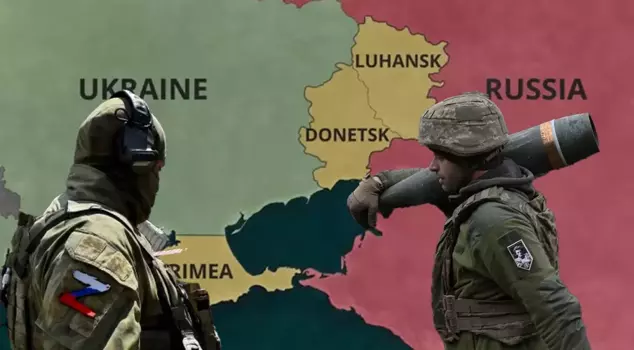
15.05.2025 09:43
The Russia–Ukraine War began with the annexation of Crimea in 2014 and the conflicts in Donbas; however, after the large military buildup at the end of 2021 and the beginning of 2022, it escalated into a full-scale war on February 24, 2022, becoming much bloodier. While global actors strive for peace, the Russian and Ukrainian delegations will meet directly today in Istanbul for the first time since 2022.
The world is focused on the Russia-Ukraine talks that will take place in Istanbul today. The Kremlin responded negatively to Ukraine's call for a Zelensky-Putin meeting. However, Putin has assigned a delegation consisting of senior Russian diplomats and defense officials. Ukrainian President Zelensky has arrived in Ankara to meet with President Erdoğan.
A FIRST SINCE 2022
The Russian and Ukrainian delegations are expected to meet in Istanbul today for direct talks for the first time since 2022.
According to a report by TASS, a Russian state news agency citing a source familiar with the talks, discussions on Ukraine are set to begin around 10:00 AM Turkish time and will be held behind closed doors.
A source stated, "It is highly likely that the talks will start around 10:00 AM at Dolmabahçe," and also provided information that the discussions will take place at the Presidential Office in Dolmabahçe Palace.
HOW DID THE RUSSIA-UKRAINE WAR START?
After gaining independence in 1991 following the dissolution of the Soviet Union, Ukraine maintained close relations with Russia due to both historical and ethnic ties. However, efforts to get closer to the North Atlantic Treaty Organization (NATO) and the European Union (EU) were perceived as a security threat by Moscow, leading to increased tensions between the two countries.
CRIMEA ANNEXED IN 2014
In February-March 2014, uniformed soldiers known as "little green men," belonging to Russia, entered Ukraine's semi-autonomous Crimea Peninsula and took control. This operation, which began between February 20-27, 2014, resulted in an annexation that violated international law.
From April of the same year, pro-Moscow separatist "people's republics" were effectively established in the Donetsk and Luhansk regions, and armed conflicts began in Eastern Ukraine. More than 14,000 people lost their lives in the clashes during this initial phase between 2014-2021.
MASSING BEGAN IN 2021
In the last quarter of 2021, Russia began to amass tens of thousands of soldiers, tanks, and artillery along the border; joint exercises were held with Belarus in January and February. Moscow demanded "security guarantees" to prevent Ukraine from joining NATO; Western countries rejected these demands and increased the threat of sanctions.
WAR BEGAN ON FEBRUARY 24, 2022
On the morning of February 24, 2022, the Russian army launched a large-scale attack on Ukraine from Belarus, the Russian mainland, and the previously annexed Crimea. This "special military operation," initiated with air, land, and naval forces, is actually described as the largest and deadliest war in Europe since World War II.
Despite expectations of rapid advancement, Ukraine's defense managed to protect the capital, turning the course of the conflict into a prolonged bombardment and siege warfare.
HERE ARE THE EVENTS STEP BY STEP IN THE RUSSIA-UKRAINE WAR
September 2022: Russia announced that it had annexed four regions (Donetsk, Luhansk, Kherson, Zaporizhzhia); the proportion of territory still controlled on the ground reached approximately 20%.
November 9-11, 2022: Ukrainian forces recaptured the strategically important city of Kherson and the right bank regions.
June 2023: The strongest mercenary group on the Russian border, Wagner, led by its leader Prigozhin, carried out a brief rebellion. The unrest was quelled with an agreement reached the next day, but it inflicted permanent damage on Russia's military command structure.
At the beginning of 2024; a new military and economic aid package of $61 billion approved by the U.S. Congress financed infrastructure and logistical preparations for Ukraine's comprehensive counteroffensive planned for spring 2025.
Throughout 2024, mutual artillery fire, drone attacks, and limited offensives intensified; the front line remained largely stable.
In May 2025, new peace talks were planned in Istanbul as part of efforts to seek a compromise. Russia announced that it would send a delegation led by Vladimir Medinsky without clarifying Putin's direct participation. Zelensky insisted that he would only meet with Putin in person. Intense diplomatic efforts from global actors are ongoing.
The war is still ongoing; Russia occupies approximately 20% of Ukrainian territory, and tens of thousands of casualties have been reported on both sides.
WHAT DOES RUSSIA WANT?
Russia demands the international recognition of Crimea, which it annexed in 2014, as well as Donetsk, Luhansk, Kherson, and Zaporizhzhia, which it declared annexed in 2022, as "Russian territory." Despite these four regions, Moscow, which still does not have full control on the ground, views them as territories that will not be returned unconditionally.
These demands are seen as "non-negotiable" by both Ukraine and Western actors, as they directly contradict Ukraine's sovereignty rights and constitutional order. Therefore, the progress of peace talks so far seems to depend on Moscow's abandonment of these maximalist conditions.